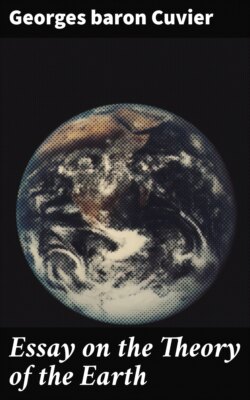Читать книгу Essay on the Theory of the Earth - Georges baron Cuvier - Страница 4
На сайте Литреса книга снята с продажи.
LIST OF PLATES.
ОглавлениеTable of Contents
| exhibits a vertical section of the Bone-Caves of Gaylenreuth, in Franconia. | |
| PlateI. | is a plan shewing the relative position of the Tertiary Mineral Formations around Paris. |
| II. | is illustrative of the Succession of the Secondary Formations, and of the Distribution of Petrifactions. |
| II | a. Extraordinary Fossil Animal named Pterodactylus longirostrus, found near Aichstedt, in Germany. |
| III. | Figure of an Ibis in a Temple in Upper Egypt. |
| IV. | Skeleton of an Ibis from a Mummy found at Thebes. |
| V. | Numenius Ibis, supposed true Ibis of the Egyptians. |
| VI. | Fossil Human Skeleton found in Guadaloupe. |
| VII. | Cervus megaceros, Irish Elk in the Museum of the Royal Dublin Society. |
| VIII. | Fig. 1. Head and Horn of the Fossil Irish Elk. It represents a larger view of the head, in which the different markings are delineated, and the expansion of the horns shewn in a front view. In this is also seen the peculiar forked appearance of the sur-antler. |
| Fig. 2. The portion of cast horn mentioned at p. 501, having the smooth convex surface at the root. | |
| Fig. 3. An internal and external view of the perforated rib, described in p. 504. | |
| IX. | Cervus megaceros, Irish or Isle of Man Elk in the Royal Museum of the University of Edinburgh. |
PLATE I.
Page 248.
PLAN Shewing the relative position of the MINERAL FORMATIONS around PARIS
10 Upper fresh water formation—Millstone—Flint—Limestone. 9 Millstone without Shells. 8 Upper marine Sandstone. 7 Sandstone & Sand without Shells. 6 Bed of Oysters. 5 Gypsum & Marl containing Bones of Animals. Lower fresh water formation Lower marine Sandstone 4 Siliceous Limestone without Shells. 3 Coarse marine Limestone. 2 Plastic Clay & Lower Sand. II. Alluvial. 1 Chalk & Flint.
W. H. Lizars Sc. Edinr. Edinburgh Published by Wm Blackwood 1827.
PLATE II.
Page 253.
SECTION Illustrative of the succession of the Secondary Formations and of the distribution of PETRIFACTIONS.
Primitive Rocks No Fossil Organic Remains. Transition Rocks First Appearance of Fossil Shells and Corals. 1st Sandstone or Old Red Sandstone & Old Red Conglomerate Fossil Wood; Fossil Fishes? 1st Limestone or Mountn Limestone Fossil Corals & Shells. 2d Sandstone or Coal Formation Impressions of Plants principally Monocotyledonous, many with a Tropical aspect. New Red Conglomerate 2d Limestone or Magnesian Limestone First appearance of Fossil Fishes and of Fossil Oviparous Quadrupeds. 3d Sandstone or New Red Sandstone Fossil Shells, Corals & Vegetables. 3d or Shell Limestone Fossil Shells. 4th Sandstone or variegated Marl Fossil Plants and Shells. 4th Limestone or Java Oolite & Lias Limestones Fossil Shells, Corals, Crustacæ, Lacertæ, Turtles. Fishes and Vegetables. 5th Sandstone or Green Sand or Quader Sandstone with Coal, Fishes, Lacertæ & Emydes. 5th Limestone & Chalk Fossil Shells, Corals, Lacertæ, Turtles & Fishes. Brown Coal Formation Crocodiles &c. also Dictyledonous Plants. Hertfordshire Puddingstone Crocodiles &c. also Dictyledonous Plants. Paris Formation First appearance of Fossil Remains of Birds & Mammiferous Animals. Diluvial Formation Remains of extinct species of Elephant, Rhinoceros, Hippopotamus, Tapir, Deer, Hyena, Bear &c. Post Diluvial Formation Fossil Remains of the Human Species first appear in this formation.
Edinburgh Published by Wm Blackwood 1827. W. H. Lizars Sc.
PLATE. II. a
Page 261.
Extraordinary animal, named PTERODACTYLUS LONGIROSTRIS found near Aichstedt in Germany.
Edinburgh Published by Wm. Blackwood 1827.
PLATE III.
Page 318.
FIGURE OF AN IBIS
in one of the Temples in UPPER EGYPT. Beak, half the natural size of a mummy Ibis. Engd. by W. H. Lizars.
PLATE IV.
Page 307.
SKELETON OF AN IBIS
extracted from a Mummy found at THEBES in EGYPT. Engd. by W. H. Lizars Edinr.
PLATE V.
Page 309.
NUMENIUS IBIX
Supposed to be the true Ibix of the EGYPTIANS. Engd. by W. H. Lizars Edinr.
PLATE VI.
Page 406.
FOSSIL HUMAN SKELETON FOUND IN GUADALOUPE Edinburgh Published by Wm. Blackwood 1827.
PLATE VII.
Page 486.
CERVUS MEGACEROS.
IRISH ELK. in the MUSEUM of the ROYAL DUBLIN SOCIETY. W. H. Lizars Sc. Edinburgh Published by W. Blackwood 1827.
PLATE VIII.
Page 492.
HEAD AND HORNS
of the IRISH ELK. Fig. 1. Fig. 2. Fig. 3. W. H. Lizars Sc. Edinburgh Published by W. Blackwood 1827.
PLATE IX.
Page 506.
CERVUS MEGACEROS,
ISLE OF MAN OR IRISH ELK. Royal Museum, College, Edinburgh. W. H. Lizars Sc. Published by W. Blackwood. Edinr. 1827.
